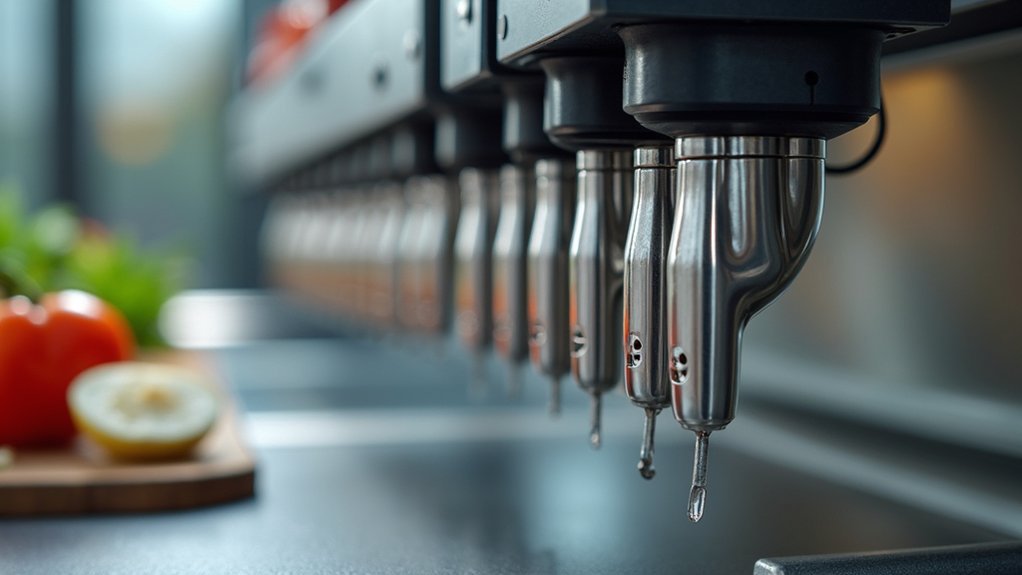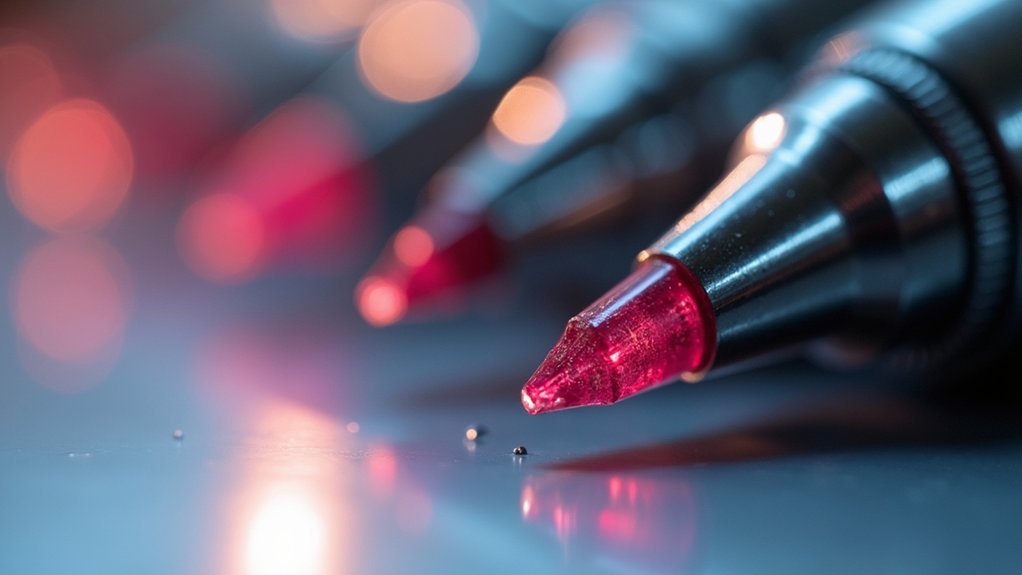You’ll want to contemplate three top food-safe nozzle options: stainless steel nozzles offer excellent corrosion resistance and eliminate heavy metal contamination while maintaining FDA compliance for high-temperature applications. Hardened steel nozzles with FDA-approved coatings provide enhanced durability for abrasive filaments and resist bacterial growth with non-reactive surfaces. Ruby-tipped nozzles deliver unmatched precision and superior thermal conductivity while maintaining hygienic standards for food contact. Each option requires consistent maintenance protocols to guarantee ideal food safety and performance throughout your printing projects.
Stainless Steel Nozzles for Superior Food Safety Compliance

When you’re printing items that’ll contact food, stainless steel nozzles deliver unmatched safety compliance through their corrosion-resistant properties.
Unlike brass alternatives containing lead, these food grade nozzles eliminate heavy metal contamination risks in your printed parts. You’ll benefit from their non-reactive nature, ensuring harmful chemicals won’t leach into food contact surfaces during extrusion.
These FDA compliant nozzles withstand high temperatures required for food safe materials while maintaining chemical resistance throughout the printing process.
Their nontoxic materials composition prevents flavor contamination, keeping your food safety standards intact. Regular cleaning of your stainless steel nozzle prevents clogs and maintains consistent material flow, further enhancing food safety.
This superior performance makes stainless steel the premier choice for food-grade 3D printing applications.
Hardened Steel Nozzles With Fda-Approved Coatings
For demanding food-grade printing applications requiring enhanced durability, hardened steel nozzles with FDA-approved coatings offer superior performance when working with abrasive filaments.
These specialized nozzles withstand high temperature printing while maintaining food safety standards through their non-reactive surface design.
Key advantages include:
- Enhanced durability – Withstands wear from abrasive filaments like carbon fiber-reinforced food-safe materials
- Temperature versatility – Handles PETG and nylon printing processes at elevated temperatures
- Safety compliance – FDA-approved coatings prevent harmful substance leaching during food contact
- Easy sanitation – Non-reactive surface resists bacterial growth and simplifies cleaning protocols
You’ll need consistent maintenance and cleaning routines to prevent clogs and guarantee consistent material flow.
The coating’s easy-clean properties make this maintenance straightforward while preserving the nozzle’s food safety integrity throughout your printing process.
Ruby-Tipped Nozzles for High-Precision Food Contact Applications

Ruby-tipped nozzles deliver unmatched precision and durability for demanding food contact applications where intricate details and flawless surface finishes are non-negotiable.
These nozzles excel in Food Safe 3D Printing by withstanding abrasive materials while maintaining consistent performance throughout extended use. Their superior thermal conductivity optimizes extrusion temperatures, directly improving print quality for every printed object you create.
You’ll achieve hygienic surfaces essential for food safety thanks to their precision design that produces smooth finishes and fine details. Ruby-tipped nozzles resist wear better than standard alternatives, ensuring high-precision results over time.
While they require a higher initial investment compared to traditional nozzles, their exceptional longevity and performance benefits make them worthwhile for serious food contact applications where quality can’t be compromised.
Frequently Asked Questions
Is PLA or PETG Safe for Food?
Both PLA and PETG are generally considered food-safe materials. You’ll find PLA’s biodegradable and PETG’s low-porosity properties make them suitable choices, though you should use proper printing practices and consider food-safe coatings for ideal safety.
Is PLA Food Safe FDA Approved?
PLA isn’t FDA approved specifically for food contact, though it’s generally considered food safe. You should verify your specific brand’s formulation and additives, as safety depends on the manufacturer’s ingredients and processes.
What Is the Food Safe Coating for PLA?
You’ll want FDA-approved epoxy resins or polyurethane sealants specifically labeled as food-safe. Apply these coatings after printing and make certain they’re fully cured to create an effective barrier against bacteria migration.
What Is the Best Food Safe Material for 3D Printing?
You’ll find PLA is the best food-safe material for 3D printing. It’s non-toxic, biodegradable, and easy to print. PETG works well too for its durability and lower porosity that reduces bacterial growth risks.





Leave a Reply